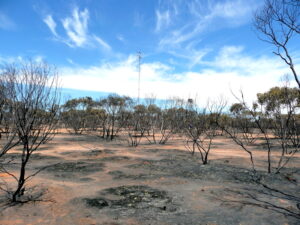It was Friday, 17 January, and TERN’s OzFlux and Australian SuperSite Network staff sat nervously, constantly checking updates on the South Australian Country Fire Service (CFS) website as a bushfire roared towards the Calperum Mallee SuperSite .
Five days of daily maximum temperatures above 44°C followed by lightning storms predisposed the area to a major fire. By Saturday morning they were still monitoring updates, and the prognosis was not looking good for the site’s OzFlux tower and its sensitive environmental monitoring systems.
Maps from the CFS indicated that the massive area burnt certainly included the flux tower site. Emails bounced around between TERN staff, no-one more concerned than the site’s Principal Investigator Professor Wayne Meyer of The University of Adelaide.
‘It is almost certain that the OzFlux tower and site at Calperum has been completely burnt,’ laments Wayne in an early email.
The automated data feed corroborated Wayne’s concerns: the last update from the site was received at 8am on Friday, and nothing came through at the scheduled 2pm call.
‘My hope is that the tower is still standing and that the instruments at the top will have survived, but it is highly likely that all the ground installations will be lost. This is very distressing,’ Wayne said.
Wayne, his technical assistant Ms Georgia Koerber and their colleagues Dr Peter Cale and Dr Grant Whiteman of the Australian Landscape Trust (ALT), which manages Calperum Station, were itching to get to the site to inspect the damage but were instructed to keep away until information came in saying that it was safe to go. Finally, on Tuesday, 21 January, Wayne, Georgia and Grant were able to visit the site.
‘The area leading to the site was variably scorched and in parts barely affected. However, around the tower looks like a moonscape,’ says Wayne.
Their initial fears were allayed when they found the tower still standing in one piece. However, a full inspection revealed a sorry story. All the instruments on the tower lower than seven metres above the ground — destroyed. Cabling to all soil flux plates, temperature sensors and soil water probes — burnt. One songmeter — ruined. Infrared thermometer — melted. Solar panels — blistered.
Despite this, some good news came when Grant was able to recover the SD memory card from the data logger that had been partly protected by a steel cabinet at the base of the tower. The Calperum team is hoping that data recording lasted long enough to provide researchers with some useful information on the timing and intensity of the fire front.
Whilst devastating for the Ozflux team, fires such as this are a normal and essential disturbance in the Mallee ecosystems in which the tower stands. The TERN SuperSite and OzFlux teams are very keen to get the site up and running as soon as possible, as it provides a great opportunity to study the recovery of the ecosystem.
The mosaic effects of the fire on the vegetation, some untouched or partially burnt, and some completely wiped out, highlight how this ecosystem has evolved and survived. To capture this, the ASN is surveying at a number of sites through the Mallee and down to the floodplain of the Murray River. It is also why the OzFlux methodology, which spatially averages over a large area, is the only viable way of measuring water and CO2 exchange in this type of ecosystem.
Despite the destruction and subsequent large sum of money and effort required to get things going again, the event has offered up a great opportunity to augment the 3.5 years of excellent data collected so far and look at the effect of fire—one of the most important processes in carbon cycling—for an important Australian ecosystem that has evolved with such disturbance.

The post-fire moonscape at the Calperum SuperSite on 21 January. The flux tower can be seen still standing despite the fire being fuelled by fiercely burning spinifex grass and mallee canopy (photo courtesy Wayne Meyer).
PostscriptBy Dr Helen Cleugh, Deputy Chief Research| Climate & Atmosphere, CSIRO Division of Marine & Atmospheric Research, and OzFlux Director 25 January ‘Whilst it is great that Wayne and his team have been able to retrieve the data recorded up until the fire; one cannot underestimate the years of effort and hard work that has now gone up, literally, in a puff of smoke. This is a real blow for the Calperum team, and for OzFlux, as we now need to start again; and rebuild the site and its infrastructure. The community spirit of OzFlux however has been demonstrated with offers of spare equipment already coming to us from across the network of Principal Investigators and researchers. The OzFlux community are very keen to assist Wayne and his team in whatever way it can to help them get the site rebuilt and data flowing again. This is a testament to the network of people that TERN and OzFlux have built – a different but important meaning to the “N” in TERN.’ |
Published in TERN newsletter January 2014







